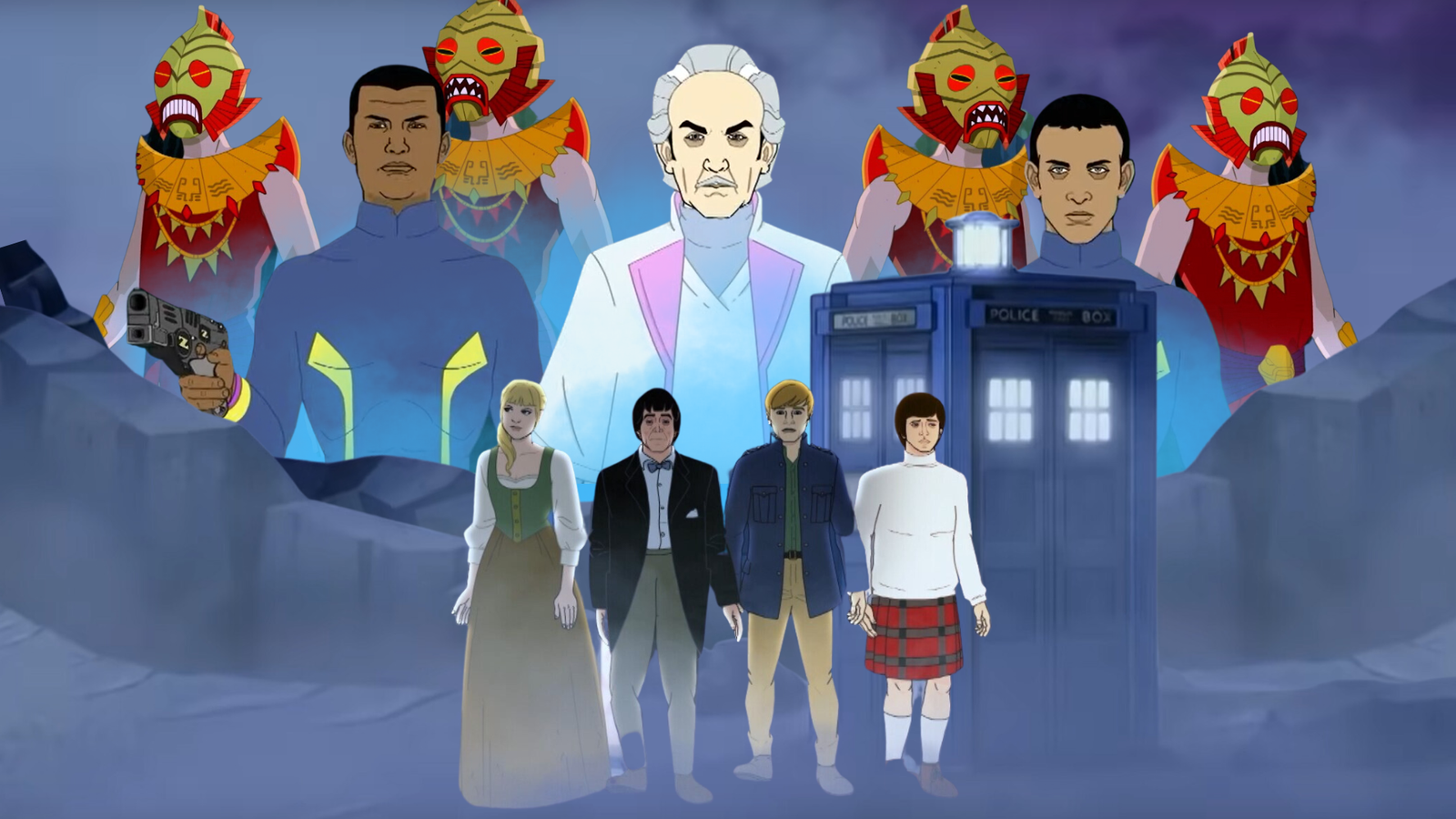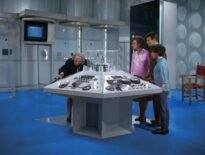Ah, The Underwater Menace. A story which often languishes at the bottom of episode polls and is spoken of in hushed voices by those who enjoy it for fear of ridicule from fellow Who fans. But is The Underwater Menace actually as bad as people think? And with the new animation, is it time the Doctor’s first excursion to Atlantis gets a reappraisal?
Let’s get this out the way: The Underwater Menace is never going to be Doctor Who’s finest hour but it’s certainly not the worst. If you are looking for a fun way to while away a couple of hours, you could do a lot worse than this. The main problem with this story is that it was a rushed production coming in to replace a story entitled The Imps; the serial suffered from a quick script turnaround, a reshuffle of lines to accommodate newcomer Jamie McCrimmon, and being given the smallest studio available at Riverside Studios. It seems like all the odds were stacked against it.
So it was a bit of a surprise, after the apparent death of the animations thanks to BBC America pulling their funding, that The Underwater Menace was next as opposed to a more popular story. Director AnneMarie Walsh said at the BFI screening she was aware that fans would have preferred a different story, but due to not being given a lot of money, they were limited on which they could actually animate. We also know that there is no Disney money involved — the BBC give the team their own small budget.
There are times in this animation where that small budget is blatantly obvious. For the most part, the animation team has done a great job and we should be grateful that we get these releases to complete the missing adventures. And while this is nowhere near as bad as Episode 3 of The Web of Fear, there are some sticky moments here and there, most notably for me the fact that they seem unable to get Anneke Wills’ likeness quite right. It’s not a problem exclusive to this release but what was very distracting was how her mouth seemed to move across her face in a way no other character’s did. It’s only really noticeable in the final episodes when things look a little rushed but one can understand why Anneke Wills isn’t overly fond of these releases.
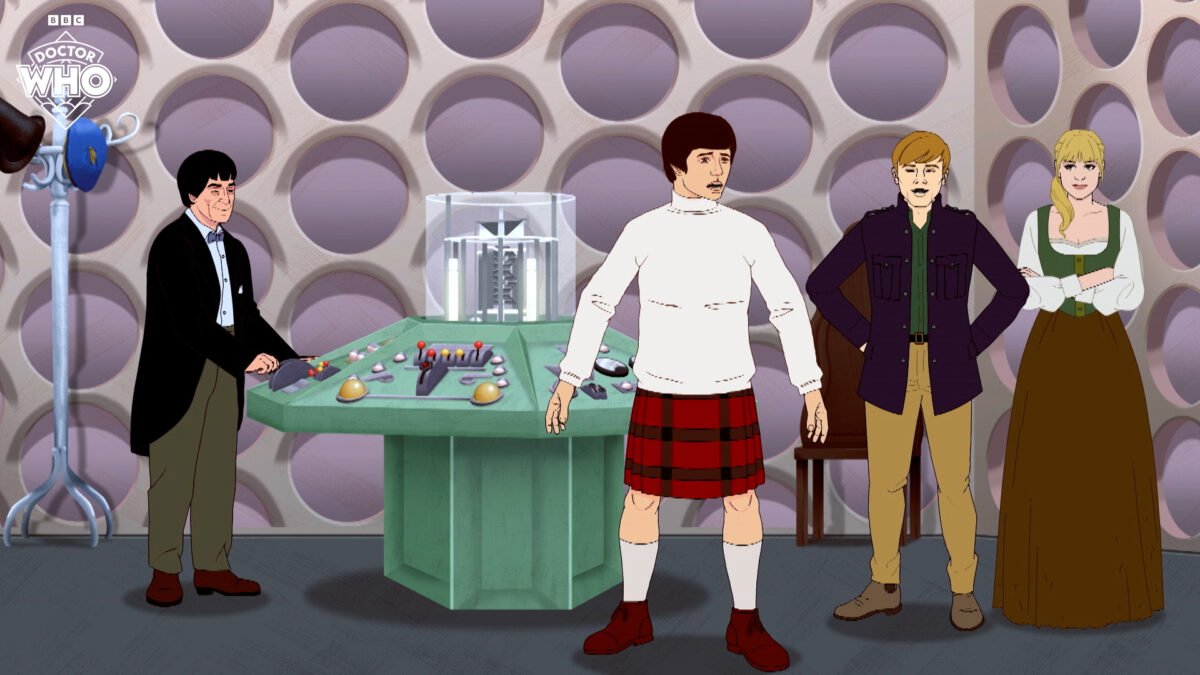
The script from Geoffrey Orme feels padded throughout and one wonders, had it had the time to be tightened up, could it have been better? There are germs of a good story here: the Doctor arrives in the lost city of Atlantis, there’s a mad scientist trying to raise the city by draining the oceans, and the Fish People, for all the flack they get, are an interesting creation from a makeup standpoint. But things never quite reach their potential: there is no reason as to why Professor Zaroff is trying to raise Atlantis beyond the fact that he simply can, nor why and how the Doctor knows who Zaroff is; and why does everyone seem to know who the Doctor is? One of the Atlanteans, Ara, played by Catherine Howe, seems very familiar with the Doctor and his friends despite not really meeting them until Episode 2. Ara is an interesting character though: at the recent DWAS Riverside Event Sea & Space, Howe — who was a guest there– said there had been some rumblings that the production team were talking about bringing her on as a companion, so it seems that there were plans to move Ben and Polly on pretty early into their time aboard the TARDIS. But this still doesn’t explain why Ara seems to know who these characters are despite never having met them before.
Another issue is that Episode 4 has some repeated animated scenes, most notably where Polly and Jamie are climbing up rocks to find a way out as Atlantis floods. Now, of course, you’ve animated these segments once so why animate them again? But it does make the final episode feel very padded. This is an issue with the script too, which feels an episode too long but simply showing the same shots over and over while the soundtrack plays in the background doesn’t make for interesting viewing. Luckily, they are kept short and those who aren’t paying attention wouldn’t notice.
Ratings at this time were slipping and Patrick Troughton was questioning his time on the show. Michael Troughton, also at the DWAS event, said that his father even blamed himself for the falling ratings, believing that he wasn’t doing a good job as the Doctor. But, if The Underwater Menace does one thing, it’s prove that wrong. Troughton is easily the best thing here, giving a brilliantly charismatic performance and somehow manages to sell how dangerous Zaroff is. He also nails the funny moments, and while this may be the last time the cosmic hobo got to dress up, you can see in the performance that none of those misgivings Troughton had translate to the screen — he completely believes in this and sells every moment.
Also to their credit, Anneke Wills, Michael Craze, and Frazer Hines sell the material, though they don’t really get much to do. Anneke Wills gets a brilliant cliffhanger where she is menaced with a needle, and Craze and Hines get to do plenty of scrabbling through mines, but they all spent so much time away from the Doctor that you forget they are supposed to be a team. That’s not entirely fair; they do all reunite in the middle of episode 3, but then get separated again very quickly.
I did like that the story poses the question of what you’d do if you ended up stranded because the Doctor dies. When Jamie and Polly escape the caves as Zaroff fills them with water, they believe the Doctor and Ben to have drowned and sit by the TARDIS looking incredibly upset. While Polly says they are only in the early 1970s in the opening episode, they are stuck in a part of the world that isn’t their own, surrounded by people who were the enemy and Jamie is a couple of hundred years from his own time. It’s a precarious place for the companions to be so I’ll give Geoffrey Orme credit for having the guts to pose this question in a time when companions were pretty safe and always got happy (ish) endings.
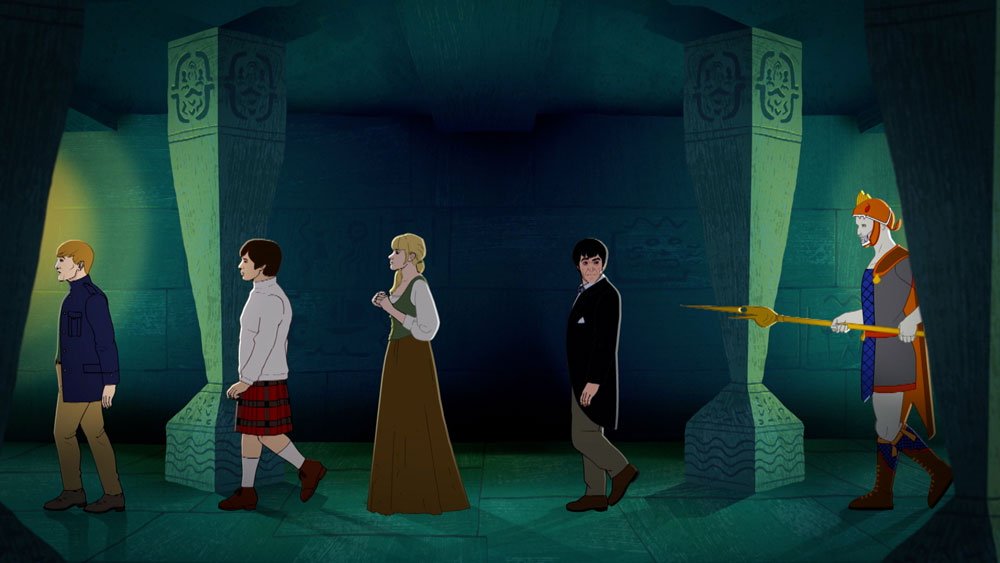
It’s very well documented that both Wills and Craze weren’t overly keen on the idea of Frazer Hines joining them because it meant the number of their lines would be cut in half. And while one can see their point, the lines are divvied up well enough so you really wouldn’t notice. Nonetheless, poor Polly doesn’t really get much to do and while she helps the Doctor capture Zaroff, she then spends the rest of the story screaming, something that shows how dodgy her animated mouth looks. I had never realised how funny Craze is as Ben. There is an excellent scene in the final episode where Ben, dressed as one of Zaroff’s guards, is helping the Doctor to get into the mad scientist’s lab. He has to use passwords to get past the guards and says of the Doctor:
“Of course he’s the prisoner — have you ever seen another berk dressed like this?!”
Troughton plays off this brilliantly, giving the two a fantastic scene together and once again highlighting that there are some great lines of dialogue littered throughout the script.
What the animation helps to emphasise, though, is that the script is an ambitious production, one that the budget and limited studio space just couldn’t accommodate; here, the animation and the soundtrack don’t quite match. While it’s lovely to see the expansive landscapes that animation can offer, there is a definite creepiness to the Temple of Amdo set in the surviving live action episodes that the animation doesn’t capture. This also brings into question the idea of creative license. AnneMarie Walsh spoke about how she thinks these animations capture what the original director would have wanted to do with a bigger budget. Personally, having seen the two surviving episodes, I think original director Julia Smith did a terrific job with the limited space and money available.
The issue of creative license also extends to the new look for the Atlanteans and the Fish People. The Atlanteans sported some very bushy eyebrows in the original, but here they are painted a light grey to make them look more fish-like. Of course, this is a colour production: painting an actor grey wouldn’t have worked in black and white but you may find yourself missing those eyebrows. Similarly, one might find themselves missing the strange makeup for the original Fish People. In the famous swimming scene which saw the Fish People going on strike, the animation doesn’t quite do the scene the justice the original did.
The new design for them too might be quite jarring for those of us who like to watch the animations with the surviving episodes in the correct places. While it’s amazing to see people bringing a new lease of life to the missing stories, I think that creative license should be taken into account here; for some viewers, it might deviate a little too much from the rightly or wrongly iconic look of the underwater creatures.
Another issue to be taken into account here is the handling of the violence in the story. Walsh spoke about how scenes such as Polly being menaced by a needle had to be toned down from the original. Indeed, the original got responses from medical professionals concerned that the needle scene would worry children who were going to hospital for operations. These are valid concerns and we are talking about children, but even nowadays (as psychotic as this might sound), people forget that children like to be scared; while we all have differing levels of things we find scary, I’ve always thought seeing Daleks exterminating people a lot scarier than what’s on offer here.
One moment I would agree with is when Zaroff stabs Ramo with a trident. The animated scene is delivered with close ups on the trident and character reactions — though in the original, we don’t actually see the trident going in, it is a particularly nasty moment that the animation handles deftly.
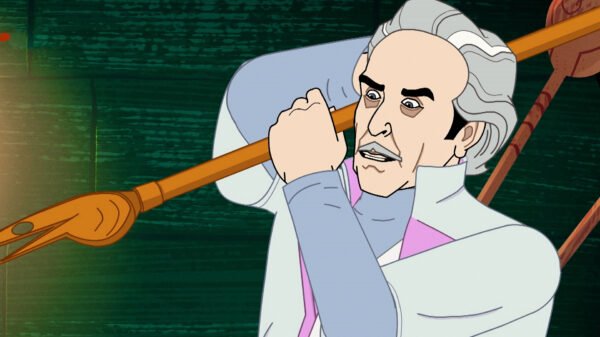
The animation handles the character of Zaroff well, making him the Bond villain that he deserved to be, by giving him shark tanks and pet octopuses that the original budget sadly wouldn’t stretch to. While the animated Zaroff loses some of the eccentricities from Joesph Furst’s performance, Zaroff comes away well here and actually, seeing the whole story, he’s a much more convincing threat than he is originally.
There is an excellent scene at the end, again edited to tone down the violence, where Zaroff is drowning. Instead of clinging onto the bars and trying to heave himself up against the water, he sees his pet octopus escape and cling onto the lever that will blow up the world. He tries to urge the creature to push it down but it leaves him and he can do nothing but wave goodbye in response. It’s a vastly different moment from the original but feels like one Furst would have happily played.
It also goes a long way showing us what a tragic character Zaroff is. Behind all the bluster and bravado, he’s just a man who has been alone his whole life and when his pet leaves him too, despite the love he shows it, you are forced to wonder if that sort of treatment might turn anyone mad in the end. The Doctor asks him at one point why he wants to blow up the world. Zaroff responds by talking about the achievement of such a feat but maybe the answer is a little more obvious: maybe these are the actions of a man who has been so unloved his entire life, he’s gone insane. If no one can show him love and kindness, then why should anyone else get that with others?
Maybe I’m reading too much into it. As with every Doctor Who story, there will be fans and those who aren’t so keen on what they are seeing. But getting to watch The Underwater Menace will hopefully give people a new appreciation for the story. It still won’t win awards and the animation can be a little clunky and jerky in places, but there is a heart to this story that wasn’t there in the surviving episodes. Orme’s script has some great ideas the budget couldn’t accommodate and while I’m not sure the animation quite reaches the heights of previous releases, this package might surprise some viewers.
Originally released as the last DVD in the Classics range, we were robbed of some extras to enjoy; luckily, this new release has plenty of extras to enjoy, two of which include a making of documentary and an episode of another series which sees Patrick Troughton and Joseph Furst acting together before The Underwater Menace.
There is a surprising charm to The Underwater Menace and things aren’t as fishy as you may think. While this is no Tomb of the Cybermen or Evil of the Daleks, The Underwater Menace isn’t as dull as The Space Pirates. I would even watch this above stories like The Dominators and The Krotons. I don’t agree with previous reviews saying this story is tacky and cheap. Zaroff is genuinely scary and the main cast are excellent here, Troughton putting in an extremely charismatic performance in particular. And while the story might not reach the heights of its ambition, you certainly can’t blame it for trying.
The Underwater Menace animation is available now on DVD, Blu-ray, and in a limited edition steelbook.
